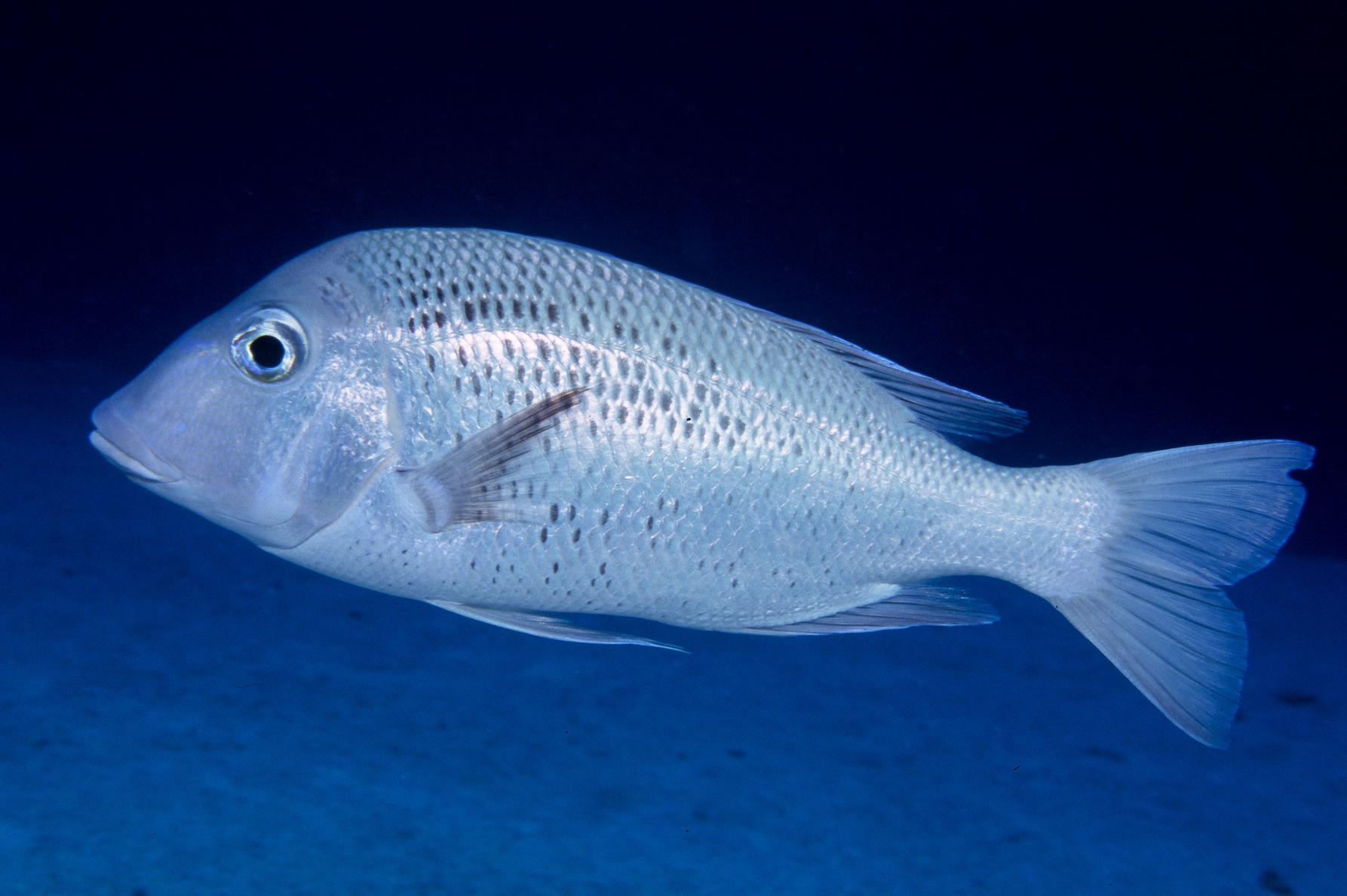Paddletail Seabream, Gymnocranius euanus (Günther 1879)
Other Names: Iodine Bream, Japanese Large-eye Bream, Japanese Sea Bream, Paddle-tailed Sea-bream

A Paddletail Seabream, Gymnocranius euanus, at Admiralty Anchor, Osprey Reef in the Coral Sea, November 2006. Source: Erik Schlogl / iNaturalist.org. License: CC by Attribution-NonCommercial
Summary:
A large silvery-grey to bluish grey seabream with small black spots scattered on the body, pinkish fins and rounded caudal-fin lobes.
Cite this page as:
Bray, D.J. 2021, Gymnocranius euanus in Fishes of Australia, accessed 01 Jul 2025, https://fishesofaustralia.net.au/Home/species/2223
Paddletail Seabream, Gymnocranius euanus (Günther 1879)
More Info
|
Distribution |
Northwest of Kalbarri, Western Australia, around the tropical north to the Solitary Islands, New South Wales; also reefs in the Coral Sea, and the Lord Howe Island region and Norfolk Island in the Tasman Sea. Elsewhere the species occurs in the tropical, west Pacific, including southern Japan, the South China Sea, New Caledonia and Tonga. Inhabits open sandy or rubble bottoms adjacent to coral reefs and on outer reef slopes, including mesophotic reefs. |
|
Feeding |
Feeds mostly on small gastropod molluscs. |
|
Fisheries |
Taken in small numbers in commercial and recreational fisheries in parts of its range. |
|
Etymology |
The species is named euanus in reference to the Eua Island in the Friendly Islands (now Tonga), the type locality. |
|
Species Citation |
Sphaerodon euanus Günther 1879, Ann. Mag. Nat. Hist. 5(4): 137. Type locality: Eua, Friendly Islands (= Tonga). |
|
Author |
Bray, D.J. 2021 |
|
Resources |
Paddletail Seabream, Gymnocranius euanus (Günther 1879)
References
Carpenter, K.E. 2001. Sparidae, Lethrinidae. pp. 2990-3050 in Carpenter, K.E. & Niem, V.H. (eds) The Living Marine Resources of the Western Central Pacific. FAO Species Identification Guide for Fisheries Purposes. Rome : FAO Vol. 5 2791-3379 pp.
Carpenter, K.E. & Allen, G.R. 1989. FAO Species Catalogue. Emperor fishes and large-eye breams of the world (family Lethrinidae). An annotated and illustrated catalogue of lethrinid species known to date. FAO Fisheries Synopsis. No. 125, Vol. 9. Rome : FAO 118 pp.
Carpenter, K.E., Lawrence, A. & Myers, R. 2016. Gymnocranius euanus. The IUCN Red List of Threatened Species 2016: e.T16719387A16722305. http://dx.doi.org/10.2305/IUCN.UK.2016-3.RLTS.T16719387A16722305.en. Downloaded on 13 February 2019.
Choat, J.H., van Herwerden, L., Robbins, W.D., Hobbs, J.P. & Ayling, A.M. 2006. A report on the ecological surveys undertaken at Middleton and Elizabeth Reefs, February 2006. Report by James Cook University to the Department of the Environment and Heritage. 65 pp.
Francis, M. 1993. Checklist of the coastal fishes of Lord Howe, Norfolk, and Kermadec Islands, southwest Pacific Ocean. Pacific Science 47(2): 136-170 figs 1-2
Gill, A.C. & Reader, S.E. 1992. Fishes. pp. 90-93, 193-228 in Hutchings, P. (ed.) Reef Biology. A Survey of Elizabeth and Middleton Reefs, South Pacific. Canberra : Australian National Parks Vol. 3, Kowari 230 pp.
Grant, E.M. 2002. Guide to Fishes. Redcliffe : EM Grant Pty Ltd 880 pp.
Günther, A. 1879. Notice of two new species of fishes from the south seas. Annals and Magazine of Natural History 5(4): 136-137
Johnson, J.W. 2010. Fishes of the Moreton Bay Marine Park and adjacent continental shelf waters, Queensland, Australia. pp. 299-353 in Davie, P.J.F. & Phillips, J.A. Proceedings of the Thirteenth International Marine Biological Workshop, The Marine Fauna and Flora of Moreton Bay. Memoirs of the Queensland Museum 54(3)
Oxley, W.G., Ayling, A.M., Cheal, A.J. & Osborne, K. 2004. Marine surveys undertaken in the Elizabeth and Middleton Reefs Marine National Nature Reserve, December 2003. Townsville : Australian Institute of Marine Sciences 64 pp.
Randall, J.E., Allen, G.R. & Steene, R. 1990. Fishes of the Great Barrier Reef and Coral Sea. Bathurst : Crawford House Press 507 pp. figs.
Randall, J.E., Allen, G.R. & Steene, R. 1997. Fishes of the Great Barrier Reef and Coral Sea. Bathurst : Crawford House Press 557 pp. figs.
Sato, T. 1986. A systematic review of the sparoid fishes of the subfamily Monotaxinae, p. 602–612, in T. Uyeno, R. Arai, T. Taniuchi, K. Matsuura (eds)Indo-Pacific fish biology: proceedings of the second international conference on Indo-Pacific fishes. Ichthyological Society of Japan, Tokyo.
Sih, T.L., Cappo, M. & Kingsford, M.J. 2017. Deep-reef fish assemblages of the Great Barrier Reef shelf-break (Australia). Scientific Reports 7(10886) https://doi.org/10.1038/s41598-017-11452-1 Open access
Speare, P., Cappo, M., Rees, M., Brownlie, J. & Oxley, W. 2004. Deep water fish and benthic surveys in the Lord Howe Island Marine Park (Commonwealth Waters): February 2004. Townsville : Australian Institute of Marine Sciences 30 pp.
Whitley, G.P. 1943. Ichthyological descriptions and notes. Proceedings of the Linnean Society of New South Wales 68(3, 4): 114-144 figs 1-12







